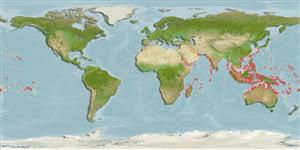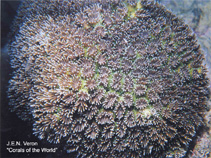Galaxea fascicularis (Linnaeus, 1767)
Galaxy coral| Native range | All suitable habitat | Point map | Year 2050 |

|
| This map was computer-generated and has not yet been reviewed. |
| Galaxea fascicularis AquaMaps Data sources: GBIF OBIS |
Classification / Names Common names | Synonyms | CoL | ITIS | WoRMS
Anthozoa | Scleractinia | Oculinidae
Environment: milieu / climate zone / depth range / distribution range Ecology
Reef-associated; depth range 3 - 25 m (Ref. 8294). Tropical; 36°N - 31°S, 32°E - 137°W (Ref. 847)
Distribution Countries | FAO areas | Ecosystems | Occurrences | Introductions
Indo-Pacific: Japan to Australia and Egypt to Tahiti.
Length at first maturity / Size / Weight / Age
Maturity: Lm ? range ? - ? cm Max length : 500 cm COLD male/unsexed; (Ref. 847)
Short description Morphology
small colonies are cushion-shaped or low domes or are irregular. Colonies are large and usually exceed 5 meters across. Corallites are of mixed sizes and are usually less than 10 mm in diameter. Tentacles are extended during the day and may be green, grey, red or brown with tentacles and septa of contrasting colors.
Depth based from occurrence (Ref. 8294); to be replaced with a better reference.
Life cycle and mating behavior Maturity | Reproduction | Spawning | Eggs | Fecundity | Larvae
Hermaphroditic (Refs. 113708, 113712). Mature gametes are shed into the coelenteron and spawned through the mouth. Life cycle: The zygote develops into a planktonic planula larva. Metamorphosis begins with early morphogenesis of tentacles, septa and pharynx before larval settlement on the aboral end (Ref. 833).
Main reference
References | Coordinator | Collaborators
Babcock, R.C. 2003. (Ref. 791)
IUCN Red List Status (Ref. 130435)
Near Threatened (NT) ; Date assessed: 03 January 2008
CITES status (Ref. 108899)
Appendix II: International trade monitored
CMS (Ref. 116361)
Not Evaluated
Threat to humans
Human uses
| FishSource |
Tools
More information
Internet sources
BHL | BOLD Systems | CISTI | DiscoverLife | FAO(Publication : search) | Fishipedia | GenBank (genome, nucleotide) | GloBI | Gomexsi | Google Books | Google Scholar | Google | PubMed | Hexacorallians of the World | Tree of Life | Wikipedia (Go, Search) | Zoological Record
Estimates based on models
Preferred temperature
(Ref. 115969): 25 - 29.3, mean 28.2 (based on 2144 cells).
Price category
(Ref. 80766):
Unknown.



